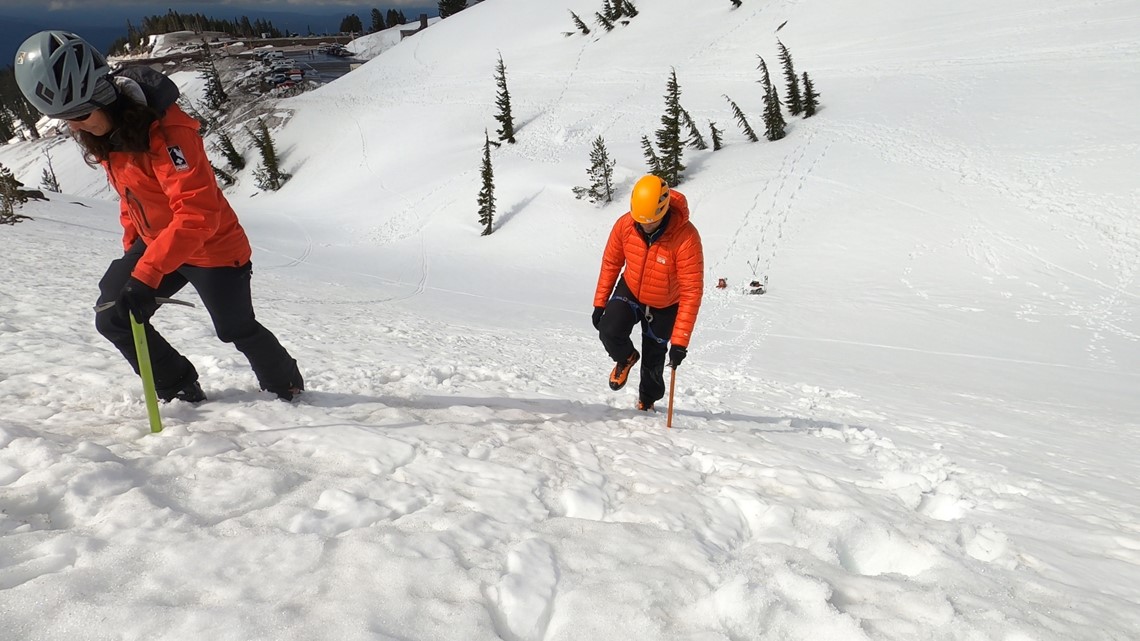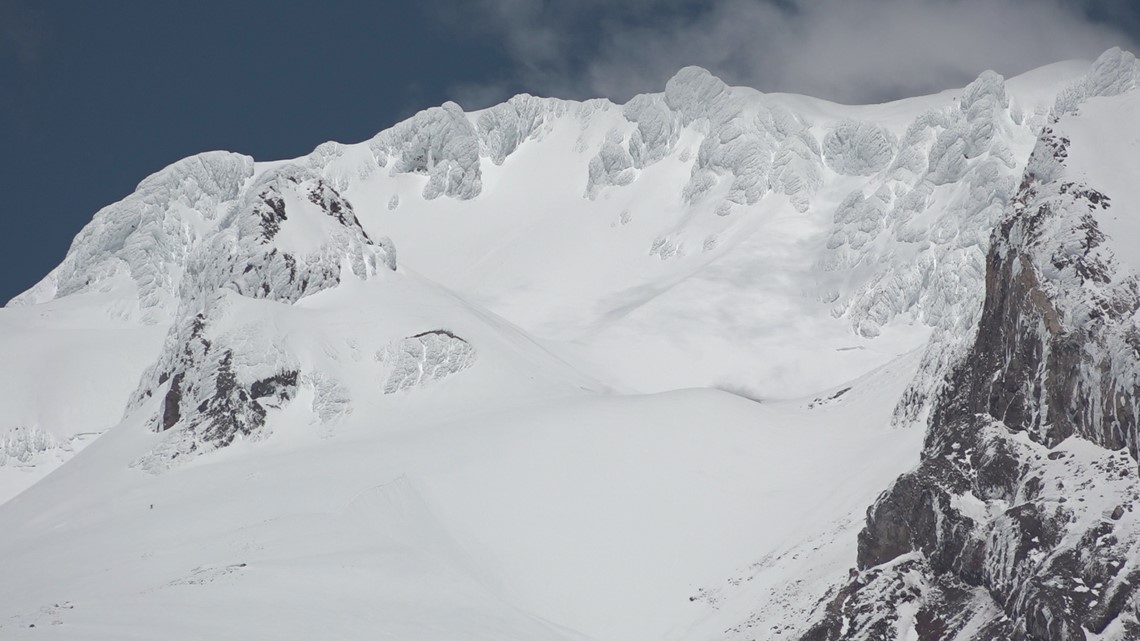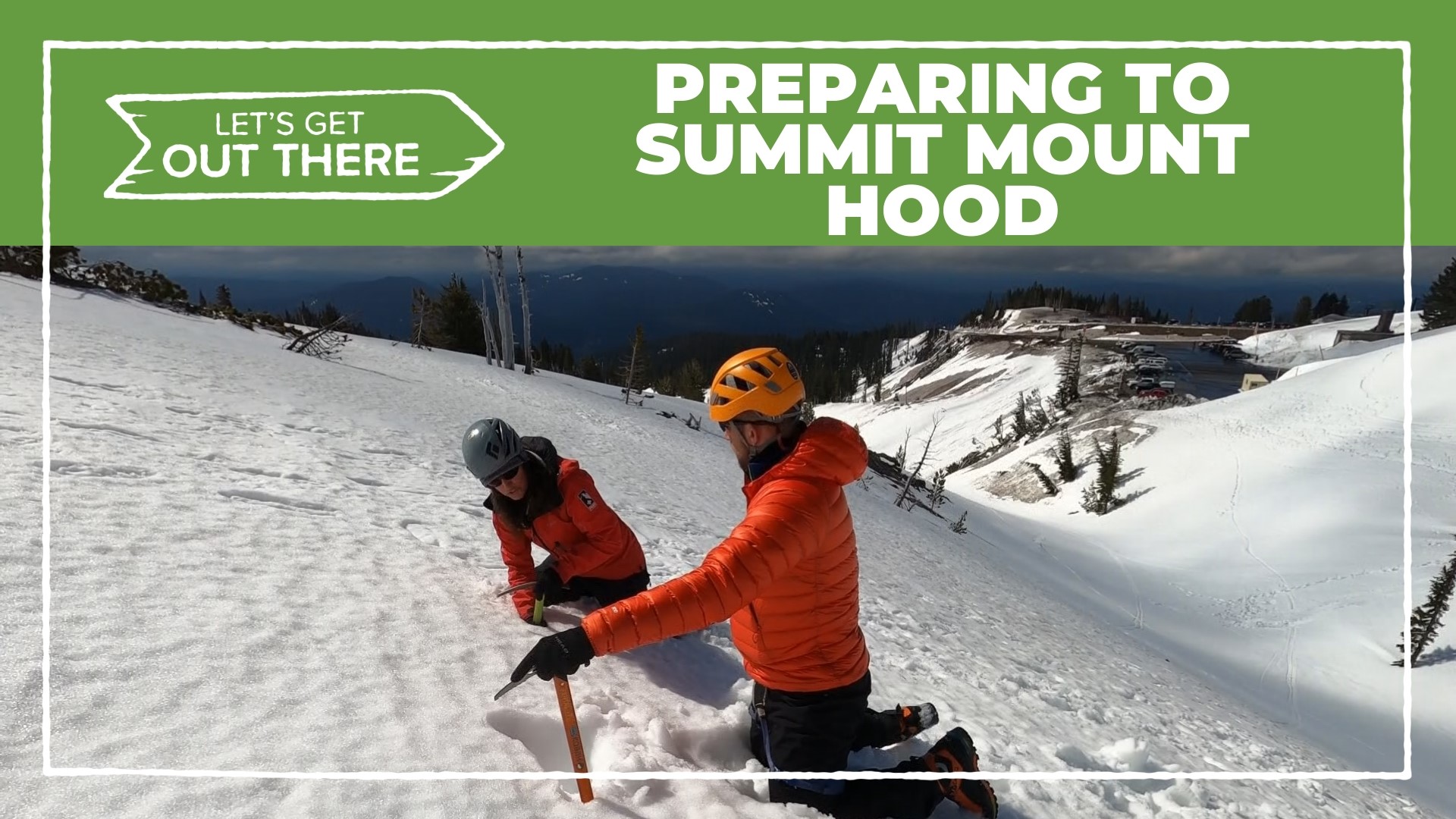MOUNT HOOD, Ore. — In this week's Let's Get Out There, we head to Mount Hood for snow school with Portland Mountain Rescue (PMR). The nonprofit organization responds when climbers get in trouble or are injured on Mount Hood. Proper gear and technical knowledge are necessary preparation for a successful summit.
One foot in front of the other. It's a steady way to attack a goal, and an obvious way to climb a mountain. Over 10,000 climbers attempt to summit Mount Hood each year. So if you've watched online videos, read trip reports and acquired proper gear, that means you’re ready to climb, right?
Not quite.
"A lot of people think that Mount Hood is a walk-up, meaning that you just literally walk up and down the mountain," said Paige Baugher of PMR. "Mount Hood is actually quite technical. It's not like Mount Adams or Mount St. Helens, which are relatively walk-ups."
On a windy morning at Timberline Lodge, hopeful climbers departed the parking lot beneath swirling clouds obscuring the goal: Mount Hood’s summit.
Baugher and PMR’s Teresa Dalsager met me in the climbers' lot for a destination lower than those of the nearby ambitious mountaineers, but no less important—snow school.
"For the snow school that we're going to do today, the snow is quite hard, and so we're going to slide on it pretty fast. So I'm going to look for a more gentle slope than I usually teach on," Baugher said.
Equipped with the gear I rented from The Mountain Shop in our previous Let’s Get Out There segment, we tested our avalanche transceivers and got our boots on the snow.


PMR’s mission of education is just as important as their search and rescue.
"Generally what a snow school does is it teaches basic technique, walking technique, crampon technique, ice axe technique, self-arrest technique," said Baugher.
First, we walked through various step techniques for ice travel.
"There's front pointing, which is probably most of what we're going to do," she said. "Because on this mountain, it's heavily traveled and there are generally well-established boot packs, which are where people have gone before."


The snow wound up being soft enough to practice several types of steps that are good for uphill travel and traversing steep slopes. It can get icy on the upper mountain, and was good getting comfortable with ice tools in a controlled setting. Baugher and Dalsager demonstrated walking uphill with an axe.
"It's not just a cane. You want to plant it, because if your feet do slip out from under you, you just fall on your axe, and then that'll stop. It's called a self-belay," Baugher said.
On an actual climb, you’d want an ice tool for each hand to give you four points of contact, including crampons.


Next we did some self-arresting, which is stopping yourself from sliding in case of a fall on a steep grade. Learning the skill is fun and important, but self-arrest is something you never want to use.
"Self-arrest is really a last resort, because once you start sliding, especially if it's icy, it's not likely that you can stop yourself," Baugher said. "Truthfully, I have never fallen. I've never had to self-belay and I've never had to self-arrest. And I blame it on my snow school teacher when I first took a snow school that emphasized footwork over everything."
Roping up and climbing on belay is another effective way to avoid falls on the higher portions of your climb. When set correctly, snow anchors are incredibly strong and offer protection and confidence closer to the summit where the incline can reach 40 degrees.


"There's a round rock at the top of the Hogsback, and going to the left of it is the left gate and going to the right of it is the right gate, the right pearly gate and the left pearly gate," Baugher said, looking up at the mountain. "Getting underneath that rock, where you can then make the choice to go either left or right, it's quite a steep traverse."
My teaching was exceptional, and we covered a lot in just a few hours. Coming in as a beginner, it certainly added confidence. No matter your skill level, don’t underestimate the mountain and don’t overestimate your skills.
One foot in front of the other, with the right gear, knowledge, and good judgment, just might get you safely to the summit — and more importantly, back home again.
"I think it's important if you're going to climb Mount Hood at any time of year to get proper professional instruction," Baugher said. "And if you are unsure as to whether you have the proper instruction, you can always hire a guiding company, which I really do encourage."
Let's Get Out there airs once a week on KGW's 4 p.m. newscast and The Good Stuff, which airs Monday-Thursday at 7 p.m. We're including viewer photos for this series. You can text your photos to 503-226-5088 or post them on the KGW Facebook page.

